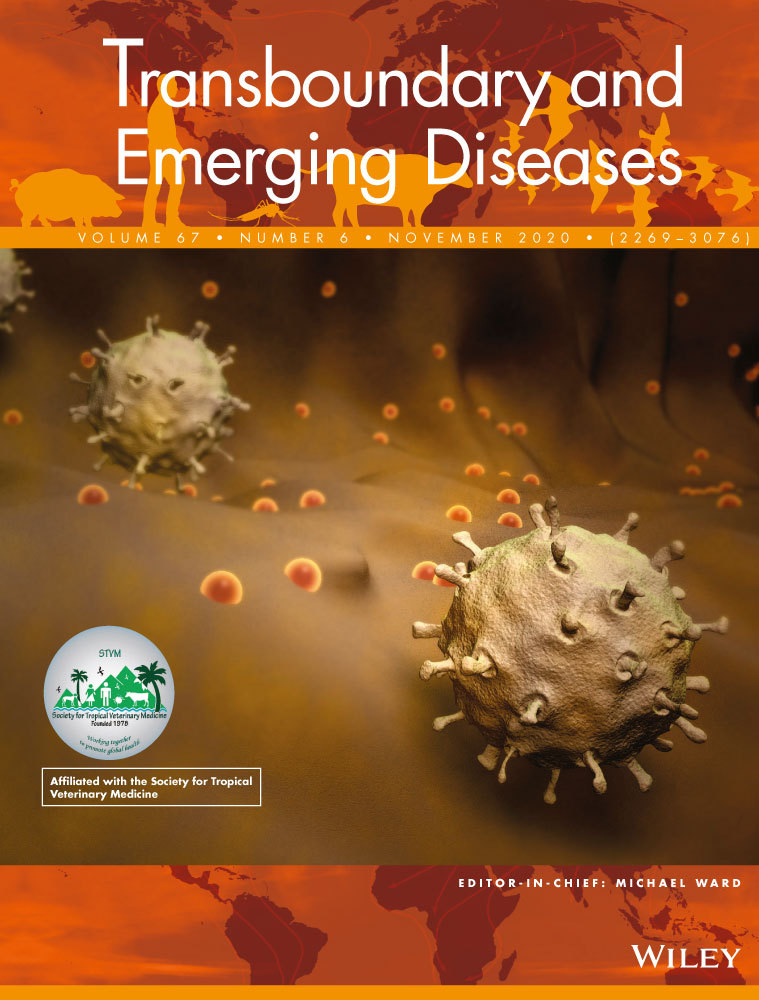Ver ítem
- xmlui.general.dspace_homeCentros e Institutos de InvestigaciónCICVyA. Centro de Investigación en Ciencias Veterinarias y AgronómicasInstituto de VirologíaArtículos científicosxmlui.ArtifactBrowser.ItemViewer.trail
- Inicio
- Centros e Institutos de Investigación
- CICVyA. Centro de Investigación en Ciencias Veterinarias y Agronómicas
- Instituto de Virología
- Artículos científicos
- Ver ítem
MANα1-2MAN decorated liposomes enhance the immunogenicity induced by a DNA vaccine against BoHV-1
Resumen
New technologies in the field of vaccinology arise as a necessity for the treatment and control of many diseases. Whole virus inactivated vaccines and modified live virus ones used against Bovine Herpesvirus‐1 (BoHV‐1) infection have several disadvantages. Previous works on DNA vaccines against BoHV‐1 have demonstrated the capability to induce humoral and cellular immune responses. Nevertheless, ‘naked’ DNA induces low immunogenic response. Thus, loading
[ver mas...]
New technologies in the field of vaccinology arise as a necessity for the treatment and control of many diseases. Whole virus inactivated vaccines and modified live virus ones used against Bovine Herpesvirus‐1 (BoHV‐1) infection have several disadvantages. Previous works on DNA vaccines against BoHV‐1 have demonstrated the capability to induce humoral and cellular immune responses. Nevertheless, ‘naked’ DNA induces low immunogenic response. Thus, loading of antigen encoding DNA sequences in liposomal formulations targeting dendritic cell receptors could be a promising strategy to better activate these antigen‐presenting cells (APC). In this work, a DNA‐based vaccine encoding the truncated version of BoHV‐1 glycoprotein D (pCIgD) was evaluated alone and encapsulated in a liposomal formulation containing LPS and decorated with MANα1‐2MAN‐PEG‐DOPE (pCIgD‐Man‐L). The vaccinations were performed in mice and bovines. The results showed that the use of pCIgD‐Man‐L enhanced the immune response in both animal models. For humoral immunity, significant differences were achieved when total antibody titres and isotypes were assayed in sera. Regarding cellular immunity, a significant increase in the proliferative response against BoHV‐1 was detected in animals vaccinated with pCIgD‐Man‐L when compared to the response induced in animals vaccinated with pCIgD. In addition, upregulation of CD40 molecules on the surface of bovine dendritic cells (DCs) was observed when cells were stimulated and activated with the vaccine formulations. When viral challenge was performed, bovines vaccinated with MANα1‐2MAN‐PEG‐DOPE elicited better protection which was evidenced by a lower viral excretion. These results demonstrate that the dendritic cell targeting using MANα1‐2MAN decorated liposomes can boost the immunogenicity resulting in a long‐lasting immunity. Liposomes decorated with MANα1‐2MAN‐PEG‐DOPE were tested for the first time as a DNA vaccine nanovehicle in cattle as a preventive treatment against BoHV‐1. These results open new perspectives for the design of vaccines for the control of bovine rhinotracheitis.
[Cerrar]

Autor
Kornuta, Claudia Alejandra;
Bidart, , Juan Esteban;
Soria, Ivana;
Gammella, Mariela;
Quattrocchi, Valeria;
Pappalardo, Juan Sebastián;
Salmaso, Stefano;
Torchilin, Vladimir P.;
Cheuquepan Valenzuel, Felipe Andres;
Hecker, Yanina;
Moore, Dadin P.;
Zamorano, Patricia Ines;
Langellotti, Cecilia Ana;
Fuente
Transboundary and emerging diseases 68 (2) : 587-597 (March 2021)
Fecha
2021-03
Editorial
Wiley
ISSN
1865-1674
Documentos Relacionados
Formato
pdf
Tipo de documento
artículo
Proyectos
(ver más)
INTA/PNBIO-1131032/AR./Desarrollo de herramientas biotecnológicas para la prevención y el control de enfermedades pecuarias: vacunas, diagnóstico y eIdemiología molecular.
Palabras Claves
Derechos de acceso
Restringido
 Excepto donde se diga explicitamente, este item se publica bajo la siguiente descripción: Creative Commons Attribution-NonCommercial-ShareAlike 2.5 Unported (CC BY-NC-SA 2.5)
Excepto donde se diga explicitamente, este item se publica bajo la siguiente descripción: Creative Commons Attribution-NonCommercial-ShareAlike 2.5 Unported (CC BY-NC-SA 2.5)

